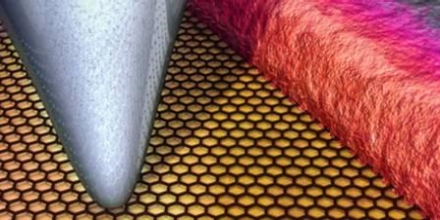April 5, 2011 — With the first observation of thermoelectric effects at graphene contacts, University of Illinois researchers found that graphene transistors have a nanoscale cooling effect that reduces their temperature.
The Illinois team used an atomic force microscope (AFM) tip as a temperature probe to make the first nanometer-scale temperature measurements of a working graphene transistor. The measurements revealed surprising temperature phenomena at the points where the graphene transistor touches the metal connections. They found that thermoelectric cooling effects can be stronger at graphene contacts than resistive heating, lowering the temperature of the transistor.
 |
|
Image: An atomic force microscope tip scans the surface of a graphene-metal contact to measure temperature with spatial resolution of about 10nm and temperature resolution of about 250 mK. Color represents temperature data. Alex Jerez, Beckman Institute Imaging Technology Group. |
Future computer chips made out of graphene could be faster than silicon chips and operate at lower power, if scientists can grasp a thorough understanding of heat generation and distribution in graphene devices.
The researchers were led by mechanical science and engineering professor William King and electrical and computer engineering professor Eric Pop.
All electronics dissipate heat as a result of the electrons in the current colliding with the device material, a phenomenon called resistive heating. This heating outweighs other smaller thermoelectric effects that can locally cool a device. The speed and size of computer chips are limited by how much heat they dissipate. Computers with silicon chips use fans or flowing water to cool the transistors, a process that consumes much of the energy required to power a device. Graphene’s apparent self-cooling effect means that graphene-based electronics could require little or no cooling.
"In silicon and most materials, the electronic heating is much larger than the self-cooling," King said. "However, we found that in these graphene transistors, there are regions where the thermoelectric cooling can be larger than the resistive heating, which allows these devices to cool themselves. This self-cooling has not previously been seen for graphene devices."
"Our measurements and simulations project that thermoelectric effects will become enhanced as graphene transistor technology and contacts improve," said Pop, who is also affiliated with the Beckman Institute for Advanced Science, and the Micro and Nanotechnology Laboratory at the U. of I.
Next, the researchers plan to use the AFM temperature probe to study heating and cooling in carbon nanotubes (CNTs) and other nanomaterials.
King also is affiliated with the department of materials science and engineering, the Frederick Seitz Materials Research Laboratory, the Beckman Institute, and the Micro and Nanotechnology Laboratory.
The Air Force Office of Scientific Research and the Office of Naval Research supported this work.
The team published its findings in the April 3 online edition of the journal Nature Nanotechnology (http://www.nature.com/nnano/journal/vaop/ncurrent/full/nnano.2011.39.html). Co-authors of the paper included graduate student Kyle Grosse, undergraduate Feifei Lian and postdoctoral researcher Myung-Ho Bae.
Follow Small Times on Twitter.com by clicking www.twitter.com/smalltimes. Or join our Facebook group

